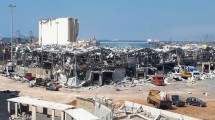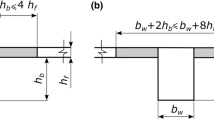Abstract
In the case of an uncontrolled demolition or a terrorist attack no prior knowledge is usually available as to what the exact explosives is and what the exact charge weight is. As well, in most cases the authorities have no idea what the target is to be in advance of an attack. For a designer to design a structure to minimize the damage in such cases is somewhat difficult if not impossible but, nevertheless, it must be done. Once the explosive, either as an improvised explosive device or vehicle improvised explosive device, has detonated the normal aftermath of such events such as fragmentation, primary and secondary fires, ground cratering and building collapse are all obvious. From a designers’ point of view, the starting point is to understand in detail all building collapse mechanisms to be able to design for such events and so allow time, if possible, for all those caught inside a building to escape and for structural damage to be minimized. To obtain such design parameters the designer must refer to past uncontrolled demolitions on Australian soil or in countries close by to gauge the most likely threat. Prior to design commencing one also must have clear criteria and strategy in mind to be able to complete a suitable design to ensure his obligation to allow time for people to escape from its collapse is met and damage is minimized. Designers not only have to address new building designs to withstand blast and ballistic loadings but also how to retrofit existing buildings cost effectively against such blast and ballistic loadings. Detailed lists of required criteria and strategies that are necessary so at to arrive at a suitable design for any blast or ballistic loadings likely to being applied to a structure are provided within the paper based on all aspects of an uncontrolled demolition (explosion) that may confront a designer.




Similar content being viewed by others
References
Agrawal, J. P. (2010). High energy materials: Propellants, explosives and pyrotechnics. Oxford: Wiley.
Ambrosini, R., Luccioni, B., Danesi, R., Riera, J., & Rocha, M. (2002). Size of craters produced by explosive charges on or above the ground surface. Shock Waves, 12(1), 69–78.
Arnold, J. L., Halpern, P., Tsai, M.-C., & Smithline, H. (2004). Mass casualty terrorist bombings: a comparison of outcomes by bombing type. Annals of Emergency Medicine, 43(2), 263–273.
Astaneh-Asl, A. (2003). Progressive collapse prevention in new and existing buildings. Paper presented at the proceedings, 9th Arab structural engineering conference, United Arab Emirates (UAE).
Barnett, R. L., & Hermann, P. C. (1968). Fragmentation of reinforced concrete slabs IL.
Cullis, I. (2001). Blast waves and how they interact with structures. Journal of the Royal Army Medical Corps, 147(1), 16–26.
Dagistanli, S., & Poynting, S. (2017). Terrorism and anti-terrorism laws. The Palgrave handbook of Australian and New Zealand criminology, crime and justice (pp. 331–345). Berlin: Springer.
Dewey, J. M. (2010). The shape of the blast wave: studies of the Friedlander equation. Paper presented at the proceeding of the 21st international symposium on military aspects of blast and shock (MABS), Israel.
Dinu, F., Dubina, D., & Marginean, I. (2015). Improving the structural robustness of multi-story steel-frame buildings. Structure and Infrastructure Engineering, 11, 1028–1041.
Goodrich, D. C., & Edwards, F. L. (2014). Improvised explosive devices. Crisis and Emergency Management: Theory and Practice, 189, 178–189.
Edwards, E. (1989). Terrorists issues & arguments (pp. 58–62). Berlin: Springer.
Evans, H. K., Tulleners, F., Sanchez, B., & Rasmussen, C. A. (1986). An unusual explosive, triacetonetriperoxide (TATP). Journal of Forensic Science, 31(3), 1119–1125.
Faramarzi, F., Farsangi, M. A. E., & Mansouri, H. (2014). Simultaneous investigation of blast induced ground vibration and airblast effects on safety level of structures and human in surface blasting. International Journal of Mining Science and Technology, 24(5), 663–669.
Gündel, M., Hoffmeister, B., Feldmann, M., & Hauke, B. (2012). Design of high rise steel buildings against terrorist attacks. Computer-Aided Civil and Infrastructure Engineering, 27(5), 369–383.
Kamara, M. E, Novak, L. C., & Rabbat, B. G. (2008). Notes on ACI 318-08 & PCA Notes on 318-08: building code requirements for structural concrete and commentary Concrete: with design applications: Portland Cement Association.
Kang, D. G., Lehman, R. A., & Carragee, E. J. (2012). Wartime spine injuries: understanding the improvised explosive device and biophysics of blast trauma. The Spine Journal, 12(9), 849–857.
Koltick, D., & McConchie, S. (2007). A neutron based vehicle borne improvised explosive device detection system. Paper presented at the security technology, 2007 41st annual IEEE international Carnahan conference on.
Linder, T., Tretyakov, V., Blumenthal, S., Molitor, P., Holz, D., & Murphy, R., et al. (2010). Rescue robots at the collapse of the municipal archive of cologne city: a field report. Paper presented at the Safety Security and Rescue Robotics (SSRR), 2010 IEEE International Workshop on.
Longinow, A. (2013). Blast protection of buildings. Practice Periodical on Structural Design and Construction, 18, 194–195.
McPhee, P. (1988). Briefings: taxing questions in NZ. Australian Left Review, 1(104), 3–4.
Mohamed, O. A. (2006). Progressive collapse of structures: annotated bibliography and comparison of codes and standards. Journal of Performance of Constructed Facilities, 20(4), 418–425.
Morrill, K., Malvar, L., Crawford, J., & Ferritto, J. (2004). Blast resistant design and retrofit of reinforced concrete columns and walls. Paper presented at the Proc of structures congress-building on the past-securing the future
Nair, R. S. (2006). Preventing disproportionate collapse. Journal of performance of constructed facilities, 20(4), 309–314.
Ngo, T., Mendis, P., Gupta, A., & Ramsay, J. (2007). Blast loading and blast effects on structures—An overview. Electronic Journal of Structural Engineering, 7, 76–91.
Remennikov, A. M. (2003). A review of methods for predicting bomb blast effects on buildings. Journal of Battlefield Technology, 6, 5.
Remennikov, A., & Carolan, D. (2005). Building vulnerability design against terrorist attacks. Paper presented at the Australian structural engineering conference 2005.
Royds, D., Lewis, S. W., & Taylor, A. M. (2005). A case study in forensic chemistry: The Bali bombings. Talanta, 67(2), 262–268.
Shi, Y., Hao, H., & Li, Z.-X. (2008). Numerical derivation of pressure–impulse diagrams for prediction of RC column damage to blast loads. International Journal of Impact Engineering, 35(11), 1213–1227.
Shi, Y., & Li, Z. (2008). Dynamic responses and failure modes of RC columns under blast loading [J]. Journal of Building Structures, 4, 016.
Shi, Y., Li, Z.-X., & Hao, H. (2010). A new method for progressive collapse analysis of RC frames under blast loading. Engineering Structures, 32(6), 1691–1703.
Smith, P. D., Hetherington, J. G., & Smith, P. (1994). Blast and ballistic loading of structures. Oxford: Butterworth-Heinemann.
Starossek, U. (2007). Typology of progressive collapse. Engineering Structures, 29(9), 2302–2307.
Stevens, D., Crowder, B., Sunshine, D., Marchand, K., Smilowitz, R., Williamson, E., et al. (2011). DoD research and criteria for the design of buildings to resist progressive collapse. Journal of Structural Engineering, 137(9), 870–880.
Stewart, M. G., & Grant, M. J. (2015). Likelihood of progressive collapse of buildings from terrorist attacks. Journal of Performance of Constructed Facilities, 31, 04016093.
Swisdak, M. (1975). Explosion effects and properties. Part I. Explosion effects in air. Retrieved from
Tabor, D. (2000). The hardness of metals. Oxford: Oxford University Press.
USA, D. (2012). UFC 4-010-01 Minimum Antiterrorism Standards for Buildings. US
Wibowo, A. (2012). Seismic performance of insitu and precast soft storey buildings.
Wu, C., & Hao, H. (2005). Modeling of simultaneous ground shock and airblast pressure on nearby structures from surface explosions. International Journal of Impact Engineering, 31(6), 699–717.
Yi, N.-H., Kim, J.-H. J., Han, T.-S., Cho, Y.-G., & Lee, J. H. (2012). Blast-resistant characteristics of ultra-high strength concrete and reactive powder concrete. Construction and Building Materials, 28(1), 694–707.
Acknowledgements
I would like to acknowledge the support and encouragement provided by Professor Bijan Samali, Doctor Chunwei Zhang in researching the area of blast loadings to structures in the Australian environment.
Author information
Authors and Affiliations
Corresponding author
Ethics declarations
Conflict of interest
On behalf of all authors, the corresponding author states that there is no conflict of interest.
Additional information
Publisher's Note
Springer Nature remains neutral with regard to jurisdictional claims in published maps and institutional affiliations.
Rights and permissions
About this article
Cite this article
McKenzie, G., Samali, B. & Zhang, C. Design criteria essential for an uncontrolled demolition (explosion). Asian J Civ Eng 20, 351–369 (2019). https://doi.org/10.1007/s42107-018-00110-0
Received:
Accepted:
Published:
Issue Date:
DOI: https://doi.org/10.1007/s42107-018-00110-0




